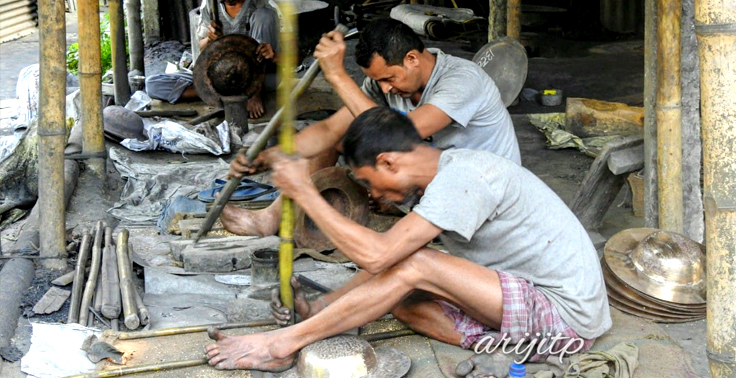By: Arijit Purkayastha
Koyeli Travels, Assam
In Assam bell metal products are as ubiquitous as bamboo handicrafts. The second largest handicraft industry of Assam, bell metal items and artefacts catch and hold attention because of how unique they appear to the eye. An alloy of copper and tin, bell metal, unlike bronze, has higher content of tin and hence preferred for making utensils for domestic and religious purpose by Assamese craftsmen.
It is in Sarthebari how one gets to see the manner in which the metal is crafted into singular pieces for use and display. Situated 90 kilometres from Guwahati, a visit to Sarthebari is not an experience that one would like to miss. It harks backs to the charming old days of yore when craftsmen would use age old tools to melt and shape metal and then mould and polish into handicrafts.
The technology is not state of the art but simple and wondrous. And watching craftsmen employ their anvils, hammers, pincers, flies, chisels tin shape and creating objects can be joyous.
Maheswar Deka of Sarthebari not has a story to tell, but also a way of expressing the magic of crafting. He crafts brass furniture - a king size bed his finest showpiece. His house itself is an institution, providing visitors with an experiential interpretation of history.
The best time to visit Sarthebari is through winter and spring since the weather is cool and dry. In the summer months, it is advisable to head out early in the morning and return late in the evening.
On the way one can visit Mughkuchi or Tilana, to see how the Jaapi is made. A hub of Jaapi-making, these villages produce thousands of this indigenous head gear. Made from bundles of tokou leaves (palm leaves) and tightly woven bamboo, Jaapi is no longer a farmer’’s hat. Today, it is the centre piece during Bihu dance performances and other socio-religious events.
ExplorIng the crafts and arts of Assam can be an awesome experience. Sarthebari is one such. Less known but immensely worthy of a visit.
.
